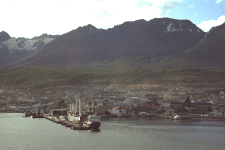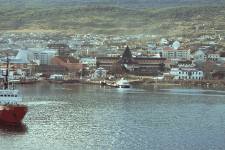

Waiting for the winds to die down near Ushuaia
Docking at Ushuaia, Argentina
Ushuaia looks like a fairly nice place. I understand that they offer tax exempt status to foreign businesses, in order to attract business and additional commerce, as well as tourism. The people here are primarily employed in light industry, and the tourism industry is bursting. They are working on completing a new airport on the far left of town, as seen from the water of the channel. I watched a large jet land there earlier this afternoon/evening. I'm told that the old airport (which they're currently using) has a notoriously short runway, and that the new one is intended to make it possible for the really large jets to land there.
I met Ethan Berkowitz, the NSF observer, ealier today also, around 6:15 or so. I first met a fellow passenger, Diane, out on deck near the very front of the ship. It was extremely windy, so we took shelter just around the corner from the forward observation deck. Diane had been interested in coming to Antarctica for about 12 years, and we were discussing the activities at McMurdo, so we soon got to the topic of the USAP Science Program that I had, and she wanted to know how to get a copy. We decided that the NSF observer on board would know, so she decided to talk to him. Amazingly, he showed up on the deck soon afterward. We talked in the freezing cold and 30 knot wind for a while about the USAP and all that's going on. He said that McMurdo's program has been extended to go beyond the February 19th end date listed in the program, due to an exceptionally good year. He also said that the Williams Field work has been finished, and that they really only needed about 40 extra berths, not 200 as the EAM I found stated. He's a very nice person, fairly young it appears. He said that he finished his undergraduate thesis on Antarctic activities in 1983, which included a trip here (at least he implied that it did). During that time, he got to know a lot of the people there.
Our parkas were just delivered here at our cabin. We'll be going to dinner shortly.
Diane mentioned that she had thoroughy researched the Antarctic exploration possibilities for civilians, and that she knew another woman who had managed to get herself reassigned to McMurdo station as an administrative assistant/clerical worker and stayed the 9 winter months. What an experience!